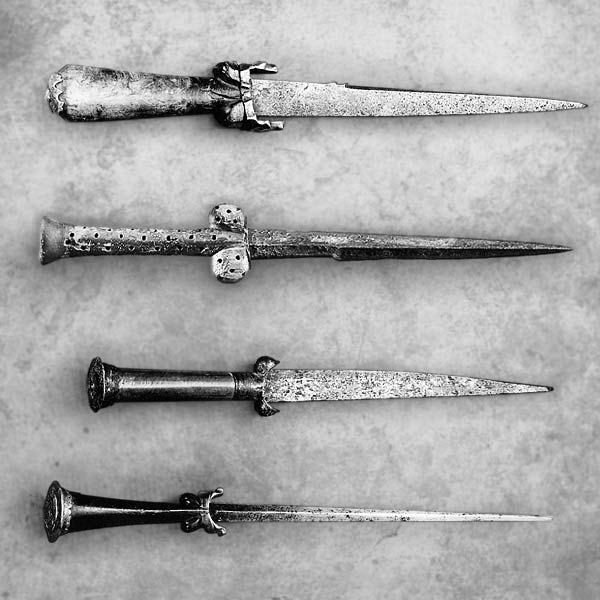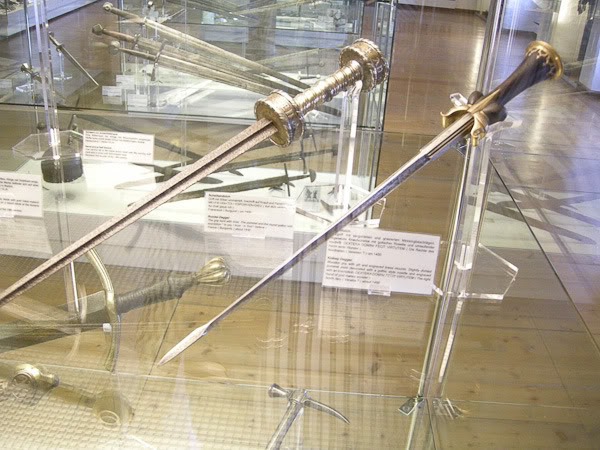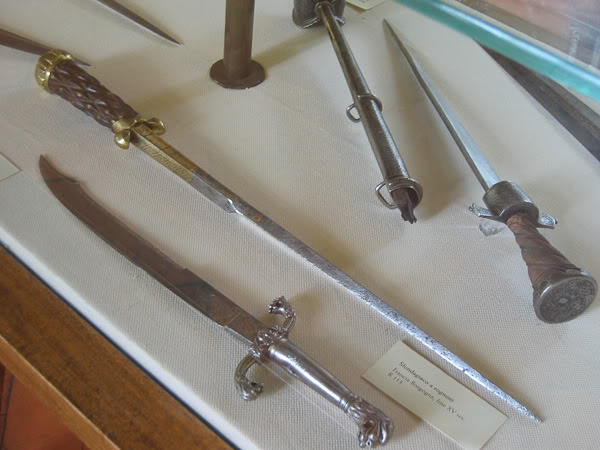| Author |
Message |
Larry Bohnham

|
 Posted: Sun 06 Feb, 2011 1:17 pm Post subject: Looking for roundel dagger recomendations Posted: Sun 06 Feb, 2011 1:17 pm Post subject: Looking for roundel dagger recomendations |
 |
|
I was hoping you good folks could steer me toward a few sources for a roundel dagger that would fit nicely with an early 15th cent kit. I've looked at the one's from A&A and KoA and wondered if there were any others out there I should look at.
Thanks as always.
"No athlete can fight tenaciously who has never received any blows; he must see his blood flow and hear his teeth crack under the fist of his adversary..."
Roger of Hoveden, d.1201
a furore Normannorum libera nos Domine
"Henry, get down off that horse with that sword, you'll put someone's eye out!" Mrs. Bolingbroke's advice to her son, Henry, on the eve of the battle of Agincourt
|
|
  |
 |
|
Joe Fults
|
|
  |
 |
Nathan Robinson
myArmoury Admin


|
|
    |
 |
Tom King

|
 Posted: Sun 06 Feb, 2011 5:40 pm Post subject: Posted: Sun 06 Feb, 2011 5:40 pm Post subject: |
 |
|
Well would you rather have a period correct rondel dagger for 200-300 dollars or a rondelesque chunck of carbon steel? My personal philosophy for combat reenactment is to get the cheapest thing possible so all those nicks and scratches don't give you a sinking sensation in the pit of your wallet 
even cheaper (and of probably better quality) are these http://www.darkwoodarmory.com/index.php?main_...ifo2565tp2 but they fall under the category of some assembly required
|
|
  |
 |
Larry Bohnham

|
 Posted: Mon 07 Feb, 2011 7:52 am Post subject: Posted: Mon 07 Feb, 2011 7:52 am Post subject: |
 |
|
Rondel dagger; merci beau coup Spell check doesn't always recognize middle English apparently. Ah well, such is the price of over reliance on technology. 
Todd's stuff has some very interesting daggers, thanks for the link.
I think I'll take some of the historical images of these daggers to a few of the local smiths and see what they might come up with. If I go that route, I'll keep everyone in the loop as to the results. We have around to two hundred blade smiths in Montana last time I checked and I like to keep the $$$ in the family whenever possible.
Should these daggers have flat or triangular blade sections or is there no set rule on that subject? The triangular blades seem to be intended to puncture armor while the flat blades seem to favor working into existing openings such as visor slits or plate gaps.
"No athlete can fight tenaciously who has never received any blows; he must see his blood flow and hear his teeth crack under the fist of his adversary..."
Roger of Hoveden, d.1201
a furore Normannorum libera nos Domine
"Henry, get down off that horse with that sword, you'll put someone's eye out!" Mrs. Bolingbroke's advice to her son, Henry, on the eve of the battle of Agincourt
|
|
  |
 |
Nathan Robinson
myArmoury Admin


|
|
    |
 |
|
Russ Ellis
Industry Professional
|
 Posted: Mon 07 Feb, 2011 8:52 am Post subject: Posted: Mon 07 Feb, 2011 8:52 am Post subject: |
 |
|
If it's purely recommendations you are looking for I would second Tod's Stuff and also I would throw Justin King's name out there. I own two of his, and he does fantastic work.
TRITONWORKS Custom Scabbards
|
|
  |
 |
|
Jeremy V. Krause
|
 Posted: Mon 07 Feb, 2011 9:41 am Post subject: Posted: Mon 07 Feb, 2011 9:41 am Post subject: |
 |
|
I would also reccommend Tod's stuff, or his other venture The English Cutler. A&A would also make you an excellent rondel.
Though, your local blacksmiths must be quite skilled if they can match the works of Tod or A&A. 
|
|
  |
 |
Larry Bohnham

|
 Posted: Thu 10 Feb, 2011 6:52 pm Post subject: Posted: Thu 10 Feb, 2011 6:52 pm Post subject: |
 |
|
I did indeed read the piece on rondel daggers and found it very informative and it did answer most of my questions regarding blade configuration.
Re: the smiths up here. I suppose I should have mentioned that they are blade smiths, although we have plenty of blacksmiths and farriers as well. Many have been producing award winning knives and other edged weapons for decades and are very skilled craftspeople.
If I get a rondel dagger I would like one that is both period accurate and a capable and durable weapon in its own right. I don't re-enact currently so I'm not bothered by the possibility of it getting damaged in that fashion. I just have a fondness for the early 15th cent and would like a piece that properly reflects what might have been in use during that time. If perchance it did get a nick or two, well one of the beauties of steel is that is can be repaired up to a point.
Thanks for all the input, I am now better educated on the subject and have resources for advancing this project if I feel so inclined.
"No athlete can fight tenaciously who has never received any blows; he must see his blood flow and hear his teeth crack under the fist of his adversary..."
Roger of Hoveden, d.1201
a furore Normannorum libera nos Domine
"Henry, get down off that horse with that sword, you'll put someone's eye out!" Mrs. Bolingbroke's advice to her son, Henry, on the eve of the battle of Agincourt
|
|
  |
 |
Christian G. Cameron

|
 Posted: Thu 10 Feb, 2011 7:51 pm Post subject: Posted: Thu 10 Feb, 2011 7:51 pm Post subject: |
 |
|
As I recently got a Rondel from Tod's I'd like to add that owning it made "sense" a lot of Rondel related techniques in Fiore. it's a crowbar with a hilt--a heavy piece of steel that can stop a heavy blade or even a poleaxe if held in a two handed grip--it can be grasped at any point on the blade--and the point will punch through steel (I've tried). It is NOT an eating knife. it is NOT a useful tool for cutting string.
In fact, it appears that it's a cultural symbol of gentility, because what it says is "I fight in armour." Sort of like a bumper sticker saying "my other suit of clothes is made of steel." In period, a guy with a Ballock dagger is saying "I have a useful knife" and a guy with a Rondel is saying "I fight in armour."
Just an impression.

Christian G. Cameron
Qui plus fait, miex vault
www.hippeis.com
|
|
   |
 |
Chad Arnow
myArmoury Team


|
 Posted: Thu 10 Feb, 2011 8:12 pm Post subject: Posted: Thu 10 Feb, 2011 8:12 pm Post subject: |
 |
|
| Christian G. Cameron wrote: | In period, a guy with a Ballock dagger is saying "I have a useful knife" and a guy with a Rondel is saying "I fight in armour."
Just an impression.
 |
What about all the ballock daggers shown on knightly effigies and brasses? Certainly that says they must have been used with armour. A number of ballock blades have forms that make them quite unsuitable as "useful knives" and only suitable as piercing battlefield weapons.

ChadA
http://chadarnow.com/
Last edited by Chad Arnow on Thu 10 Feb, 2011 8:32 pm; edited 1 time in total
|
|
    |
 |
|
Jeremy V. Krause
|
 Posted: Thu 10 Feb, 2011 8:22 pm Post subject: Posted: Thu 10 Feb, 2011 8:22 pm Post subject: |
 |
|
| Chad Arnow wrote: | | Christian G. Cameron wrote: | In period, a guy with a Ballock dagger is saying "I have a useful knife" and a guy with a Rondel is saying "I fight in armour."
Just an impression.
 |
What about all the ballock daggers shown on knightly effigies and brasses? Certainly that says they must have been used with armour. A number of ballock blade forms that make them quite unsuitable as "useful knives" and only suitable and piercing battlefield weapons. |
Interesting Chad,
I did not know that some ballock blades were made this way. That's really interesting. So some blade forms were devoid of a singular sharp edge- being of a square, diamond, trapazoid, or other shape?
Are these basically more typical rondel blades on ballock hilts? I know that many rondels did have cutting edges but I am wondering about the purely piercing designs.
Looks like I have to start looking at picking up a ballock, rondel or three. . . . darn. . . 
|
|
  |
 |
Chad Arnow
myArmoury Team


|
 Posted: Thu 10 Feb, 2011 8:31 pm Post subject: Posted: Thu 10 Feb, 2011 8:31 pm Post subject: |
 |
|
| Jeremy V. Krause wrote: | Interesting Chad,
I did not know that some ballock blades were made this way. That's really interesting. So some blade forms were devoid of a singular sharp edge- being of a square, diamond, trapazoid, or other shape?
Are these basically more typical rondel blades on ballock hilts? I know that many rondels did have cutting edges but I am wondering about the purely piercing designs.
Looks like I have to start looking at picking up a ballock, rondel or three. . . . darn. . .  |
Sure there are piercing blades on ballock daggers.  Just check out our ballock spotlight: Just check out our ballock spotlight:
The second and fourth daggers have piercing blades:

Or these:





Or from the Extremely Long Daggers thread:


And I'm sure there are more. 
I'm not sure what you mean by "typical rondel blades." There is no one typical blade form. There are single edged, double-edged, non-edged blades in both ballock daggers and rondels.

ChadA
http://chadarnow.com/
|
|
    |
 |
Nathan Robinson
myArmoury Admin


|
 Posted: Thu 10 Feb, 2011 8:36 pm Post subject: Posted: Thu 10 Feb, 2011 8:36 pm Post subject: |
 |
|
| Jeremy V. Krause wrote: | I did not know that some ballock blades were made this way. That's really interesting. So some blade forms were devoid of a singular sharp edge- being of a square, diamond, trapazoid, or other shape?
Are these basically more typical rondel blades on ballock hilts? I know that many rondels did have cutting edges but I am wondering about the purely piercing designs.
Looks like I have to start looking at picking up a ballock, rondel or three. . . . darn. . .  |
This is addressed in our Spotlight Article. The article shows many examples and amongst them are blades of various cross-sections including some very unusual ones. Here's an excerpt from the article:
Ballock dagger blade styles varied considerably. One of the first and most common forms was a single-edged, triangular section blade that tapered evenly from hilt to point. The blade was sometimes reinforced for piercing with the end becoming quadrangular near the point. These styles seem to have persisted throughout the dagger's considerable lifespan. By 1400 an evenly tapered double-edge blade became popular and by 1450 the double-edge blade became slender with a thick diamond cross section that sometimes included a ricasso. This later style continued throughout the 16th century with the diamond cross-section becoming so thick that it could almost be considered four-sided. These four-sided blades are the most frequently found form on 16th century ballock daggers.
There is no such thing as a "rondel blade". Rondel daggers are defined by their hilts, not by their blades. Both rondel daggers and ballock daggers have a wide variety of blade types that span an incredibly diverse selection of cross-sections, lengths, purposes, etc. These daggers are named because of their hilts.
.:. Visit my Collection Gallery :: View my Reading List :: View my Wish List :: See Pages I Like :: Find me on Facebook .:.
|
|
    |
 |
|
Jeremy V. Krause
|
 Posted: Thu 10 Feb, 2011 11:20 pm Post subject: Posted: Thu 10 Feb, 2011 11:20 pm Post subject: |
 |
|
This is great to read and I will certainly delve more into the variety of blade forms and the diversity of cross section in both the rondel and ballock daggers,
My ignorance on this matter should be attributed to my rather narrown concentration on the period (1000-1300).
I should have done at least a modicum of research before jumping right into the thread here.  Now I feel like a "noob"! Now I feel like a "noob"! 
|
|
  |
 |
Nathan Robinson
myArmoury Admin


|
 Posted: Thu 10 Feb, 2011 11:37 pm Post subject: Posted: Thu 10 Feb, 2011 11:37 pm Post subject: |
 |
|
| Jeremy V. Krause wrote: | I should have done at least a modicum of research before jumping right into the thread here.  Now I feel like a "noob"! Now I feel like a "noob"! |
Please allow me to add a bit of encouragement here and say that this is the whole point of the site and these very forums: the idea of asking questions and getting pointed in a direction that leads to answers. I'm often humbled by the experience, but it's that very process that I value so I keep letting it happen to me. 
.:. Visit my Collection Gallery :: View my Reading List :: View my Wish List :: See Pages I Like :: Find me on Facebook .:.
|
|
    |
 |
Leo Todeschini
Industry Professional

|
 Posted: Fri 11 Feb, 2011 12:37 am Post subject: Posted: Fri 11 Feb, 2011 12:37 am Post subject: |
 |
|
I have often wondered about effigies and bollock daggers. There are for sure many effigies that show the man in full armour etc and with a bollock dagger, but there would have been other more suitable military daggers for men of this means, such as rondel and quillon daggers. I mean by more suitable, ones with stronger guards as at least in the early days of bollock daggers they usually lack substantial guards.
So it brings me back to why? I wonder if it is that they could be made quite flashy or that they were just in fashion and when a fight really was on the horizon they would get replaced with something more robust. I know there will be a million paintings of bollock daggers worn into battle, but this is just my suspicion.
Jeremy, just as Nathan said, these daggers are defined by their hilts not their blades, and again this place is all about learning, but I would support you in assuming that if 'John Doe' had a bollock dagger it would be single edged 'v' and his rondel would be a heavier single edged 'v'. But Mr Average aside, pretty much anything you can think of and plenty you can't; existed.
Tod
www.todsworkshop.com
www.todcutler.com
www.instagram.com/todsworkshop
https://www.facebook.com/TodsWorkshop
www.youtube.com/user/todsstuff1
|
|
   |
 |
Christian G. Cameron

|
 Posted: Fri 11 Feb, 2011 4:22 am Post subject: Posted: Fri 11 Feb, 2011 4:22 am Post subject: |
 |
|
It wouldn't surprise me, given the late 14th and 15th c., to find Rondel hilts on very practical blades...this is the period of appearance over reality, and looking like a dangerous hombre probably was more important to some than being one...
I merely meant that Leo's work caused me to "understand" at some level, what these knives could do...
Christian G. Cameron
Qui plus fait, miex vault
www.hippeis.com
|
|
   |
 |
|
Jeremy V. Krause
|
 Posted: Fri 11 Feb, 2011 11:12 am Post subject: Posted: Fri 11 Feb, 2011 11:12 am Post subject: |
 |
|
I really like the look of the ballock dagger in the second to last pic, with the reinforced tip.
I do wonder if the blade behind the reinforcement is sufficiently stout for combat? It looks a bit dainty.
|
|
  |
 |
Chad Arnow
myArmoury Team


|
 Posted: Fri 11 Feb, 2011 11:38 am Post subject: Posted: Fri 11 Feb, 2011 11:38 am Post subject: |
 |
|
| Jeremy V. Krause wrote: | I really like the look of the ballock dagger in the second to last pic, with the reinforced tip.
I do wonder if the blade behind the reinforcement is sufficiently stout for combat? It looks a bit dainty. |
It's probably at least as thick as an average screwdriver shank which is hardy enough for all kinds of things if the material is good. My Arma Bohemia ballock dagger is pretty slight but would still be sturdy enough for its intended purpose: stabbing through gaps in armour (like eye-slits) and through clothing.

ChadA
http://chadarnow.com/
|
|
    |
 |
|
|

